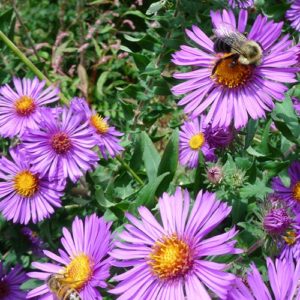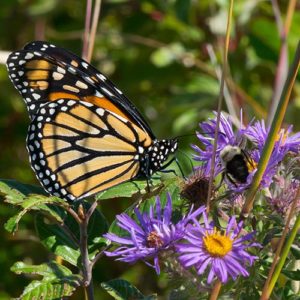New England aster (Symphyotrichum novae-angliae) is a late summer / early fall blooming wildflower that is native throughout most of North America. In the last decade or so, it has become a fairly common plant to include in native plant and pollinator gardens, as well as, in larger habitat restoration projects. However, it was introduced to the European horticulture trade centuries ago and has long been popular there.

General Biology and Life History of New England Aster
New England aster naturally grows in prairies, open lands, savannahs, and sometimes open woods. In the wild, it prefers medium to moist soils, but will grow in a wide range of soil moistures and types. New England aster can grow up to 5 or 6 feet tall, although 3 to 4 feet is often more common.
Like with all asters, New England aster “flowers” are actually a composite of lots of smaller flowers making up the flower head that we commonly refer to as the flower. Each flower head is composed of a central disk of yellow flowers that produce both nectar and pollen. These central flowers are called disk flowers and contain both male and female reproductive parts. Once they are pollinated, they change to a more orangey brown color.
What we see as “petals” when we look at an aster flower are actually another type of flower called a ray flower. In the Symphyotrichum genus, each ray flower contains female reproductive parts, but no male reproductive parts. So, although the ray flowers’ primary purpose is to provide a visual cue to draw in pollinators, each one can also produce a single seed.
The ray flowers are typically a bright medium purple that is really beautiful surrounding the bright yellow disk flowers. However, there is a lot of diversity when it comes to the ray flower coloration of New England asters. The ray flowers can be practically any shade of purple, even a lavender that is so light as to appear almost white. In addition, they can be multiple shades of pink. I’ve even seen New England asters where part of the plant had the traditional medium purple ray flowers, while the other part had light lavender ray flowers.
New England aster flowers primarily bloom in the late summer and early fall. In Kentucky, that means late August / early September through sometime in October. However, just like with the color of the ray flowers, the bloom time can vary. This is a phenomenon that can be seen in both cultivated and wild plants.
In my gardens and nursery, it isn’t uncommon for me to see the first New England aster blooms sometime in late June, with a few more scattered blooms appearing in July, and then the primary bloom starting up in August or September. I’m really not sure why some of them start blooming so early and I haven’t met anyone else who has a good answer either. I haven’t marked individual plants to track when they bloom, but just going by memory, I don’t think that the same plants always bloom early or late. If that’s true then it would imply that the bloom time isn’t genetically controlled. Like I said, I don’t have an answer for this one.

Pollinator and Wildlife Uses
New England asters, like many of our late summer and fall blooming wildflowers are extremely important sources of nectar and pollen for our late season pollinators. Many different species of bees including bumble bees, honey bees, mining bees, and leaf cutter bees will visit the flowers to collect nectar and/or pollen. Monarchs and a wide range of other butterflies will also visit the flower to drink the nectar. In the case of monarchs and other migrating butterflies, the flowers can be an extremely important fuel source for their fall migration. Many other insects such as flower flies, soldier beetles, and bee flies will also visit the flowers. In addition, New England asters are a host plant for pearl crescent caterpillars and several species of checkerspot caterpillars. Songbirds will sometimes eat the seeds later in the season.
Incorporating New England Aster into Your Yard
New England aster is a highly adaptable and relatively easy to grow native wildflower in the landscaped setting. It can grow in most soils that aren’t extremely wet or extremely dry. However, it is relatively drought tolerant once established and can take short periods of fairly wet soils. New England aster prefers full sun, but can also take partial shade. (It is doing quite well in one of my gardens where it gets mostly morning sun.) If you have a small space or prefer container gardening, New England aster can also be successfully grown in containers.
In many areas, deer herbivory is a major concern for garden plants. Deer will eat New England aster, but it is not a preferred food source. The good news is that even if it is browsed by hungry deer, that’s typically not a problem. New England aster evolved with browsing pressure and usually isn’t killed by it. Instead, it often produces lots of new growth at the points where it was browsed, which creates a bushier plant with more flower heads. In fact, a little artificial deer browsing in the form of trimming can be done in May and June to help promote bushiness, more flowers, a shorter overall growth form, and a later bloom time.
New England aster can be kind of aggressive in some areas. It does spread, both vegetatively and by seed, but it won’t take over if paired with equally aggressive plants. In my gardens, it is on par with my wild bergamot / bee balm (Monarda fistulosa), but no where near as aggressive as my cup plant (Silphium perfoliatum).
If you are really concerned about its ability to spread, start with only one plant. New England aster can’t pollinate itself. So, if you only have one plant, then any seeds it produces will be infertile, and thus you only have to worry about it spreading vegetatively unless a pollinator brings pollen in from somewhere else. Of course, a single, individual plant also tends to be less attractive to pollinators. Another option is to simply deadhead the plants to keep the seeds from developing.
As the season progresses, New England aster leaves will often turn colors and dry up on the stem. The lower leaves will dry up and fall off first, with the condition progressing up the stem. By the time the plant blooms, there may only be a few leaves left on the stem and those will be concentrated up by the flowers. This is a natural occurrence with New England aster and isn’t an indicator of poor health or disease. But, because of it, you may want to plant something else that maintains prettier foliage in front of your New England aster to hide the bare stems later in the season.
New England aster is a fairly common plant for native plant nurseries in the eastern U.S. If you don’t know of a native plant nursery in your area, then check with your state’s native plant society. Many native plant societies maintain a list of local nurseries that carry native plants. If they don’t have a list, their members can still often offer great advice on where to find native plants near you. There are also several cultivars available through the traditional horticulture trade.
Summary
New England asters are a great plant to consider if you are looking for a native wildflower that is easy to grow, grows in a wide variety of conditions, and is beneficial to a wide variety of bees and butterflies. It is also a great plant to include in monarch waystations and other butterfly gardens because it provides a late season source of nectar for the fall migration.

Leave a Reply to Backyard Ecology Cancel reply